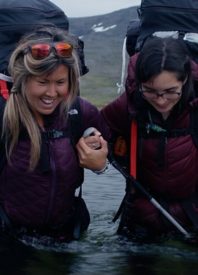
Caroline Cote and Florence Pelletier are filmmakers who are part of a Quebecois cinematic landscape. It’s one that’s starting to pay more attention to female stories. They previously worked together on a short that they call Reaching the Crest, about an alpinist. This time around they’re back together to document their own journey. They, along with three other women, travel through the Great Quebecois North. They film their travelling companions two at a time, beginning with their plane ride to their first stop.
This film, Passages, also draws comparisons to other films, documentaries or otherwise, where it subjects or characters explore nature. This might be obvious to say, but it’s often less about the actual setting and more about the people traversing it. One of the explorers is Dominique, who wants to see a new self after embarking on this voyage. It’s mostly about her and the other two companions who spend the first leg of the voyage walking, finding confidence in that activity.
The other companions’ relative lack of experience in outdoor activities make this slightly more compelling than the average nature documentary. Besides, there are a lot of things helping them with their voyage. Some of these include their 21st century gear, which is probably where most of the budget went. Another thing that helps them is how quickly they forge their bonds as they make their starts and stops. Dominique becomes a mother figure to the younger companions Christine and Katrena.
There are some parts and aspects in Passages that might bring very strong and ambivalent reactions. The first is how it handles Indigenous issues. It’s understandable for Christine and Katrena to talk about their experiences as Indigenous and Inuk women. That’s more important because they pass as white. But others might see the introduction of that theme as a spoiler. This might be problematic for generations or political ideologues who are more up front about their identities and backgrounds.
The film also makes it a point to spend three minutes on a certain leg of the voyage in a way that slows it down. And as familial as these women become, of course there’s a moment where they don’t get along. And it depicts those scenes as if it’s giving something that some viewers ask for. But despite those setbacks, it seems like these women forged an unforgettable bond. The switches from the actual voyage to the interviews where all are honest about their love for each other.
- Release Date: 12/4/2020

